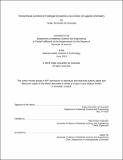Hierarchical control of hydrogel dynamics via choice of ligand chemistry
Author(s)
De Quesada, Felipe Alexander.
Download1117775387-MIT.pdf (1.280Mb)
Other Contributors
Massachusetts Institute of Technology. Department of Materials Science and Engineering.
Advisor
Niels Holten-Andersen.
Terms of use
Metadata
Show full item recordAbstract
Hydrogel networks formed via dynamic metal-coordination chemistry display remarkable mechanical properties, such as self-assembly, stimuli-responsiveness, and the ability to self-heal. Recent efforts have looked into expanding the prevailing knowledge of metal ion-coordination chemistry to nanoparticle-ligand interactions, with the goal to further provide rational control over the mechanical properties of the gel. Although studies have focused on varying nanoparticle size and shape, little work has been conducted to understand how the choice of ligand chemistry affects the macroscopic gel dynamics. This thesis investigates the orthogonal control of macroscopic gel dynamics via variations in the choice of ligand chemistry. More specifically, 4-arm poly(ethylene glycol) (4-PEG) functionalized with either catechol, nitro-catechol or terpyridine end groups are crosslinked with either iron(III) ions (i.e. Fe³⁺) or ferrite nanoparticles (i.e. Fe₃O₄). Rheological and spectroscopic measurements show that the macroscopic dynamic behavior of gels can be controlled orthogonally from the choice of metal chemistry and polymer architecture via choice of ligand chemistry and that this choice can be guided by the activation energy barrier for the dissociation of the metal-ligand complex. In addition, the range of accessible gel dynamics can be further expanded by adjusting the pH of the gel and combining the choice of ligand chemistry with other design parameters. These findings allow to create tailor-made hierarchical relaxation moduli in soft structural matter and further adapt the dynamic behavior to any given application.
Description
This electronic version was submitted by the student author. The certified thesis is available in the Institute Archives and Special Collections. Thesis: S.B., Massachusetts Institute of Technology, Department of Materials Science and Engineering, 2019 Cataloged from student-submitted PDF version of thesis. Includes bibliographical references (page 36).
Date issued
2019Department
Massachusetts Institute of Technology. Department of Materials Science and EngineeringPublisher
Massachusetts Institute of Technology
Keywords
Materials Science and Engineering.